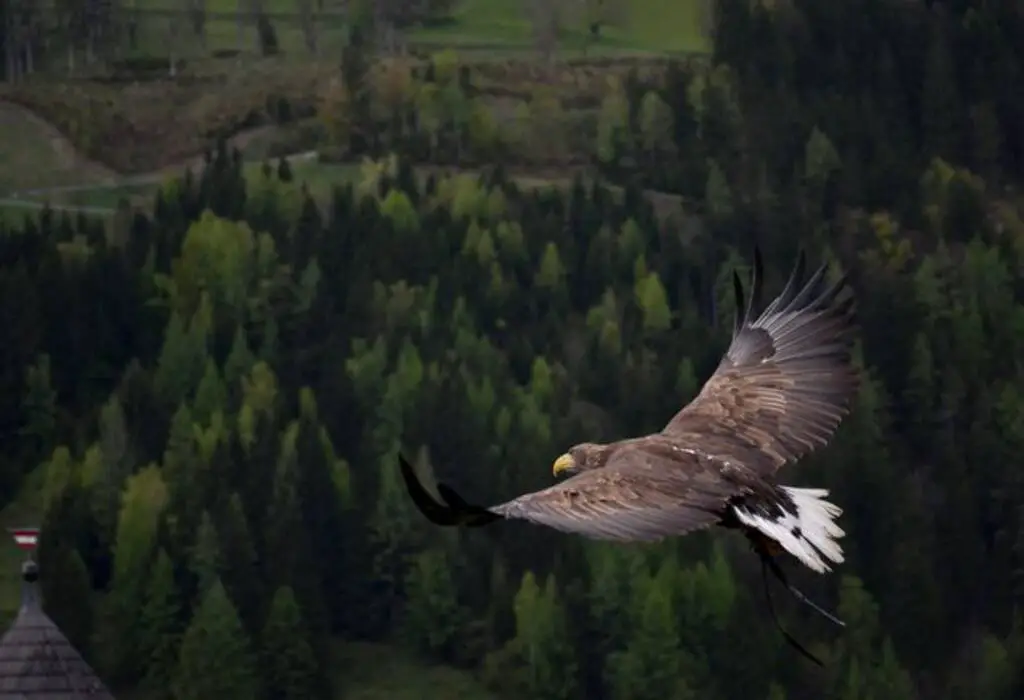How Do Eagles Hunt? Prepare to be mesmerized by the regal prowess of these awe-inspiring birds of prey. With hunting skills that defy size and gravity, eagles are masters of the hunt.
Their remarkable adaptations, from piercing vision to powerful talons and beaks, equip them for capturing prey that surpasses their own size.
But hunting is more than brawn; it demands intelligence and adaptability. Join us on an exhilarating journey as we unravel the secrets behind the anatomy, techniques, and ingenuity of eagle hunting.
Discover how these majestic creatures navigate challenges and conquer their prey with unparalleled finesse.
Table of Contents
- 1 Key Takeaways
- 2 Overview of Eagle Anatomy and Capabilities
- 3 The Importance of Keen Eyesight
- 4 The Power of Eagle Talons
- 5 The Sharpness of Eagle Beaks
- 6 Adaptability in Hunting Techniques
- 7 How Do Eagles Hunt
- 8 Aerial Hunting Tactics
- 9 Ground Hunting Tactics
- 10 Cooperation Among Eagles
- 11 Hunting Challenges and Limitations
- 12 Frequently Asked Questions
- 12.1 What is the average lifespan of an eagle?
- 12.2 How do eagles communicate with each other during a hunt?
- 12.3 What is the maximum distance an eagle can fly in one day while searching for prey?
- 12.4 How do eagles adapt to changes in their environment and prey availability?
- 12.5 What role do eagles play in their ecosystem beyond hunting?
- 13 Conclusion
- 14 Author
Key Takeaways
- Eagles have exceptional adaptations, including keen eyesight, powerful talons, sharp beaks, and impressive anatomy, which make them formidable hunters.
- Aerial hunting tactics involve various techniques for catching prey, with hunting fish and birds requiring specialized skills.
- Ground-based hunting tactics rely on stealth, speed, camouflage, and terrain, while social hunting behavior involves cooperative tactics, bait-and-switch, and surround-and-conquer strategies.
- Despite facing challenges such as prey size and weight, environmental factors, and habitat considerations, eagles are capable of capturing prey much larger than themselves, thanks to their excellent eyesight, speed, and sharp talons and beaks.

Overview of Eagle Anatomy and Capabilities
The anatomy of eagles, including their powerful talons, keen eyesight, and strong wings, enables them to effectively hunt prey in a variety of environments.
Eagle flight is characterized by a combination of powerful wing beats and gliding, which allows them to soar at great heights and survey their surroundings for potential prey.
Their impressive wingspan also gives them the ability to fly at high speeds and make sudden turns, which is crucial during hunting behavior.
Additionally, eagles possess sharp and powerful talons that enable them to grasp and hold onto their prey.
The importance of keen eyesight cannot be overstated – eagles have the ability to see prey from great distances and can even spot prey underwater.
With their impressive anatomy and capabilities, eagles are able to successfully hunt and thrive in various habitats.
The Importance of Keen Eyesight
Keen eyesight is an essential tool for birds of prey in their search for prey. Eagles possess some of the keenest eyesight in the animal kingdom, with visual acuity up to eight times greater than humans.
This incredible vision allows eagles to spot potential prey from great distances, even while in flight.
Eagles also have binocular vision, which allows them to focus on a single object with both eyes, providing depth perception and aiding in the accuracy of their attacks.
Additionally, eagles have a membrane called the nictitating membrane, which acts as a third eyelid to protect their eyes while hunting.
The importance of keen eyesight for eagles cannot be overstated, as it is a crucial component of their hunting strategies.
By being able to spot prey from afar and accurately target their attacks, eagles are able to successfully capture their prey and survive in their environment.
The power of eagle talons will be discussed in the next section.
The Power of Eagle Talons
With a grip strong enough to crush bones, the razor-sharp talons of eagles are a deadly weapon in their arsenal.
Talon strength plays a crucial role in the hunting efficiency of eagles, allowing them to snatch prey in mid-flight or swoop down to grab prey on the ground.
The talons of eagles are curved and sharp, designed to pierce through the flesh and hold onto their quarry.
They have four talons on each foot, with the front ones being larger and stronger than the back ones.
These talons are capable of exerting a force of up to 400 pounds per square inch, making them one of the strongest grips in the animal kingdom.
To put this into perspective, that’s strong enough to lift animals twice their own weight. The talons are also equipped with spicules, small spikes that help the eagle maintain its grip even on slippery surfaces.
The talons of eagles are truly a remarkable feat of nature, showcasing the incredible power and precision of these magnificent birds.
Speaking of precision, the sharpness of eagle beaks is another crucial aspect of their hunting technique.
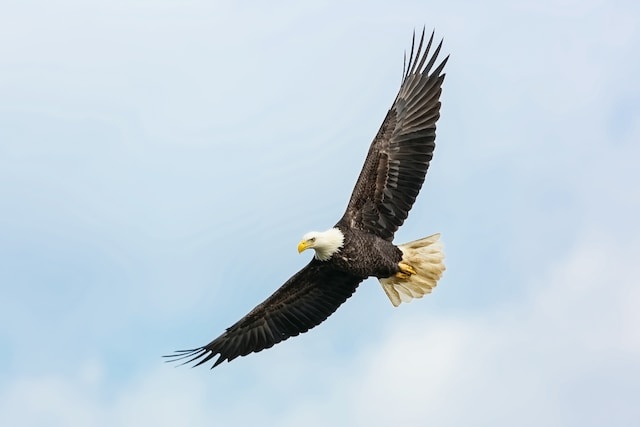
The Sharpness of Eagle Beaks
Eagle beaks are not only sharp, but they also play a vital role in the bird’s survival. The strength of an eagle’s beak is impressive and allows it to rip apart prey efficiently.
The beak is used not only for tearing flesh, but also for stripping off the feathers and skin of the prey.
The upper and lower beaks of an eagle interlock perfectly, providing a powerful grip on their prey.
This strength is necessary for hunting large prey, such as rabbits or smaller mammals, which require a lot of force to subdue.
The eagle’s beak also allows it to hunt in a very efficient manner, as it can quickly kill its prey with a swift jab or bite.
This hunting technique is crucial for the eagle’s survival, as it must conserve energy and time while hunting to ensure its own survival.
The eagle’s beak strength and hunting efficiency are just some of the adaptations that make it one of the most formidable hunters in the animal kingdom.
Moving ahead, we will explore the adaptability in hunting techniques.
Adaptability in Hunting Techniques
One of the remarkable characteristics of raptors is their ability to adapt their hunting techniques to different environments and prey.
Eagles, in particular, are known for their adaptability in hunting. They are skilled hunters in a variety of environments, from forested areas to open fields and bodies of water.
Hunting adaptation is essential for eagles to survive, as their prey is not always available in the same locations or under the same conditions.
For example, eagles that hunt fish will use different techniques depending on whether they are hunting in a river or a lake.
Similarly, eagles that hunt small rodents will employ different strategies depending on whether they are hunting in the forest or open fields.
This adaptability is what makes eagles such successful hunters, and allows them to thrive in a variety of habitats.
Moving forward, to truly understand the hunting abilities of eagles, it is necessary to explore their aerial hunting tactics.
How Do Eagles Hunt
Eagles hunt with impressive skills, leveraging their keen eyesight, powerful talons, and sharp beaks. They employ various strategies like soaring, stalking, and surprise attacks.
With remarkable adaptations, eagles capture prey larger than themselves. Intelligence and adaptability enable them to navigate challenges in the environment.
Discover the fascinating world of eagle hunting and their unparalleled hunting techniques.
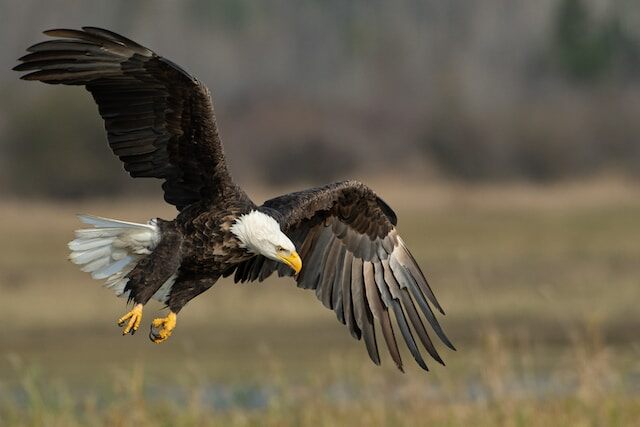
Aerial Hunting Tactics
Aerial hunting tactics are an essential aspect of eagle behavior.
Eagles are known to hunt fish and birds, using various techniques to catch their prey.
When hunting fish, eagles can be observed hovering over the water surface and then diving down to catch their prey.
In contrast, when hunting birds, eagles use a stealthy approach, often waiting in ambush and then attacking their target with great speed and agility.
Hunting Fish
The hunting of fish by birds of prey is a highly specialized behavior that is influenced by a variety of factors.
Firstly, the size and shape of the bird’s beak and talons play a crucial role in their fishing techniques.
For instance, the osprey has evolved to have a sharp, curved beak and long, sharp talons that allow it to dive into the water and catch fish with ease.
Secondly, the speed and agility of a bird’s flight is essential in hunting fish. Birds like the peregrine falcon can reach speeds of up to 240 mph, allowing them to swoop down and catch fish in a split-second.
Thirdly, the availability and behavior of the prey species must be taken into account.
Some birds, like the bald eagle, rely on their powerful wings and keen eyesight to spot and snatch fish from the surface of the water.
Lastly, prey selection is also an important aspect of fishing for birds of prey. They will often target fish that are larger than what they can carry, but not too large that they cannot lift them off the water.
The hunting of birds by eagles is a different story altogether.
Hunting Birds
Birds of prey have developed specialized hunting techniques to catch other birds, taking into account factors such as size, speed, and behavior of their prey.
Some eagles, such as the golden eagle, are known for their ability to take down birds much larger than themselves, such as geese and cranes.
They use their powerful talons to grab their prey mid-air, and then quickly kill it with their sharp beak.
Other eagles, such as the bald eagle, primarily hunt fish, but they also have been observed catching other birds, such as seagulls and waterfowl.
These eagles will often take advantage of bird migration patterns, waiting at choke points where large numbers of birds are funneled through a narrow area.
They will then swoop down and catch their prey as it flies by.
In addition to these specific hunting behaviors, eagles also rely on their exceptional eyesight and hearing to locate and track their prey.
With their keen senses and impressive hunting tactics, eagles are truly remarkable predators.
Moving onto the subsequent section about ‘ground hunting tactics’…
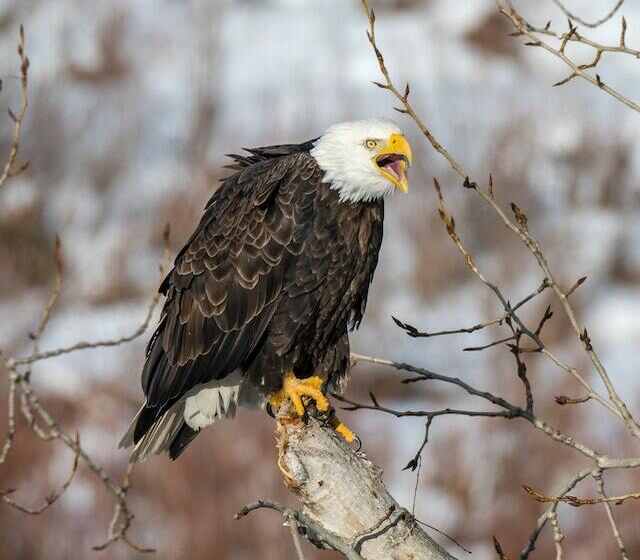
Ground Hunting Tactics
Ground-based hunting tactics of eagles are characterized by stealth and speed, as they stalk their prey with a silent and swift approach.
These tactics involve the use of camouflage techniques and the utilization of terrain to their advantage.
Eagles blend in with their surroundings by using their feathers to match the color of the ground or rocks, making them almost invisible to their prey.
They also use the terrain to their advantage by hiding behind rocks or bushes, waiting for the perfect moment to strike.
Once they spot their prey, eagles use their powerful legs and sharp talons to capture it.
They can reach speeds of up to 200 miles per hour when diving towards their prey, making them one of the fastest animals on the planet.
Additionally, eagles have excellent eyesight, which allows them to spot their prey from great distances.
This combination of speed, stealth, and sharp senses makes eagles formidable hunters on the ground. However, eagles also exhibit cooperative hunting behaviors, which will be discussed in the next section.
Cooperation Among Eagles
Ground hunting tactics are not the only way that eagles can successfully capture prey. In fact, some species of eagles exhibit social behavior and communication skills that allow them to work together in hunting.
Here are some examples of how eagles cooperate during hunting:
- Some eagles engage in ‘bait-and-switch’tactics, where one eagle distracts the prey while another swoops in for the kill.
- Other eagles use ‘surround and conquer’strategies, where they work together to circle around the prey and attack from different angles.
- Some eagles even engage in vocal communication during hunting, using specific calls to coordinate their movements and alert each other to the location of prey.
Social hunting behavior is most commonly seen in species of eagles that live in groups, such as the African fish eagle and the White-bellied sea eagle.
These cooperative hunting tactics are thought to increase the success rate of capturing prey, as well as reducing the risk of injury to individual eagles.
While eagles have evolved impressive hunting skills, they are not without challenges and limitations.

Hunting Challenges and Limitations
The hunting challenges and limitations faced by eagles are influenced by various factors such as prey size and weight, as well as environmental conditions.
The size and weight of the prey can pose difficulties for eagles, especially when attempting to lift off with heavy prey.
Environmental factors such as wind conditions and terrain can also affect the success of an eagle’s hunt.
Prey Size and Weight
When hunting, eagles typically target prey that is smaller and lighter than themselves. This prey selection is critical for their hunting success, as larger prey may be too difficult to capture, overpower, and carry.
Moreover, eagles have a preference for prey that is not only small but also slow-moving and vulnerable, such as fish, rodents, and reptiles.
This preference allows them to use their exceptional eyesight, speed, and agility to their advantage.
Additionally, eagles rely on their sharp talons and curved beaks to grab and kill their prey quickly and efficiently.
As majestic and powerful as eagles are, they still need to be strategic in their hunting approach to ensure success.
Understanding the prey size and weight is just one of the many environmental factors that eagles must consider when hunting.
Environmental Factors
Having explored how prey size and weight affect eagle hunting, it is also important to consider the environmental factors that impact their hunting behavior.
Climate effects, such as temperature and wind patterns, can greatly influence the availability and behavior of prey, which in turn affects eagle hunting strategies.
For example, eagles may choose to hunt at different times of the day or in different locations depending on the weather conditions.
Habitat considerations are also crucial, as eagles require a diverse range of habitats for hunting, roosting, and nesting.
The availability of suitable habitats can affect the density and distribution of prey, as well as the level of competition among eagles for resources.
By understanding these environmental factors, we can gain a deeper appreciation for the complex and dynamic nature of eagle hunting behavior, and develop more effective conservation strategies to protect these majestic birds.

Frequently Asked Questions
What is the average lifespan of an eagle?
Exploring Eagle Lifespan: Research and Facts reveal that the average lifespan of an eagle varies among species, with some living up to 30 years. Understanding Eagle Aging: Causes and Effects involves factors such as predation, disease, and environmental stressors.
How do eagles communicate with each other during a hunt?
Eagles communicate during a hunt using vocalizations and body language. They make high-pitched screams and whistles to signal to their partners. They also use head movements and wing flapping to coordinate their movements. This helps them to efficiently hunt and catch prey.
What is the maximum distance an eagle can fly in one day while searching for prey?
An eagle’s flight endurance varies by species, age, and weather conditions. However, some eagles can fly up to 200 miles in one day while searching for prey, utilizing their hunting techniques to scan the terrain for potential targets. Their aerial prowess is comparable to a skilled navigator charting a course through the skies.
How do eagles adapt to changes in their environment and prey availability?
Eagles employ various adaptive strategies to cope with changes in their environment and prey availability. Prey selection is influenced by factors such as prey size and behavior. Such adaptive strategies allow eagles to maintain their survival and reproductive success.
What role do eagles play in their ecosystem beyond hunting?
Eagles play a crucial role in their ecosystem beyond hunting as they regulate the predator-prey dynamics. Eagle conservation is vital in maintaining a healthy ecosystem, ensuring the survival of other species and maintaining the balance of nature.
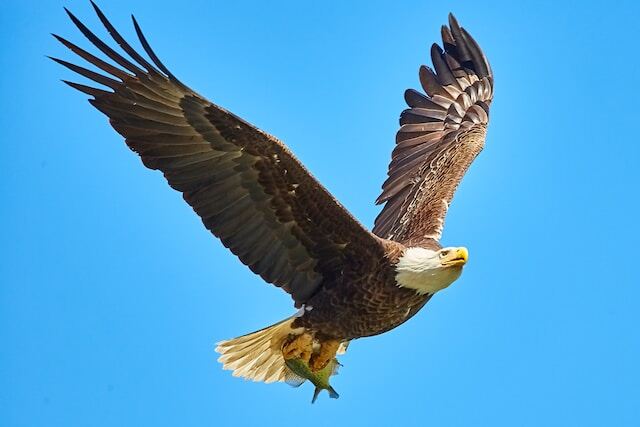
Conclusion
In conclusion, the hunting abilities of eagles are unparalleled in the animal kingdom.
Their anatomy and capabilities, such as keen eyesight, powerful talons, and sharp beaks, allow them to adapt to various hunting techniques and overcome challenges in both aerial and ground hunting.
Furthermore, eagles exhibit remarkable cooperation in hunting, working together to catch prey that may be too large for one bird to handle alone.
However, despite their impressive skills, eagles do face limitations in their hunting abilities, such as their inability to swim or dive for extended periods of time.
In summary, the hunting strategies of eagles are a testament to their evolutionary adaptations and survival instincts.
Their prowess in hunting is a result of their unique physical attributes, adaptability, and cooperation, making them one of the most fearsome predators in the animal kingdom.

